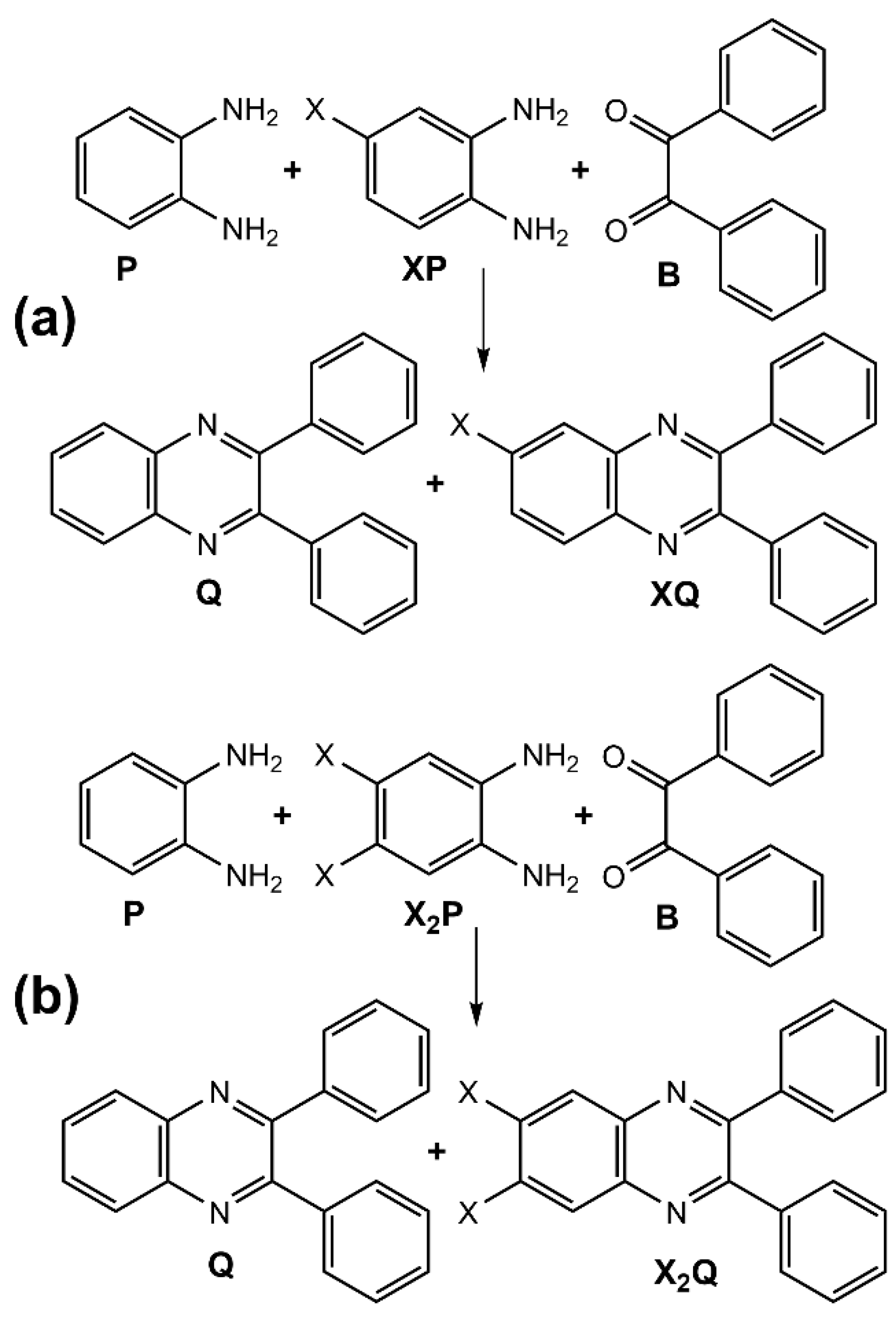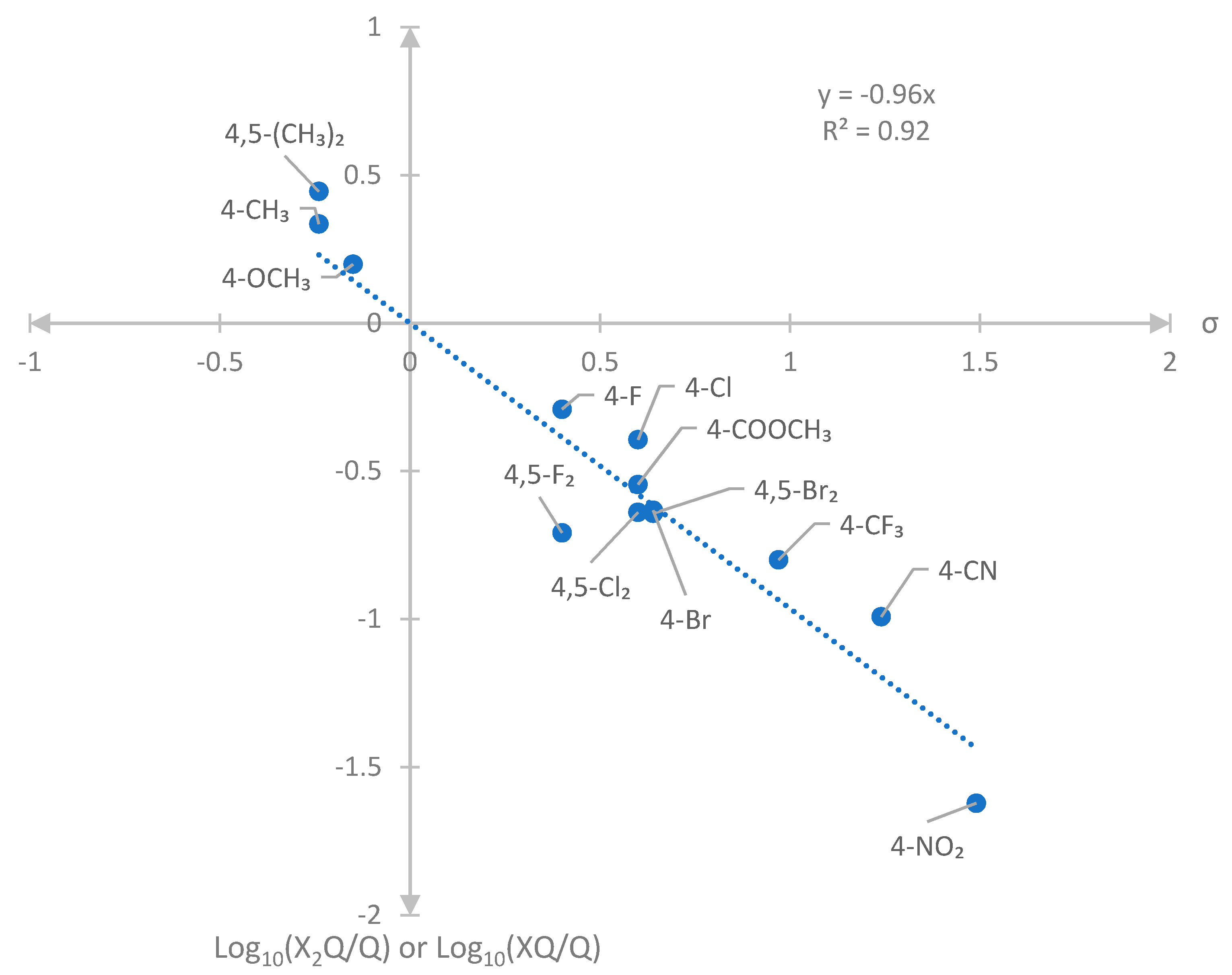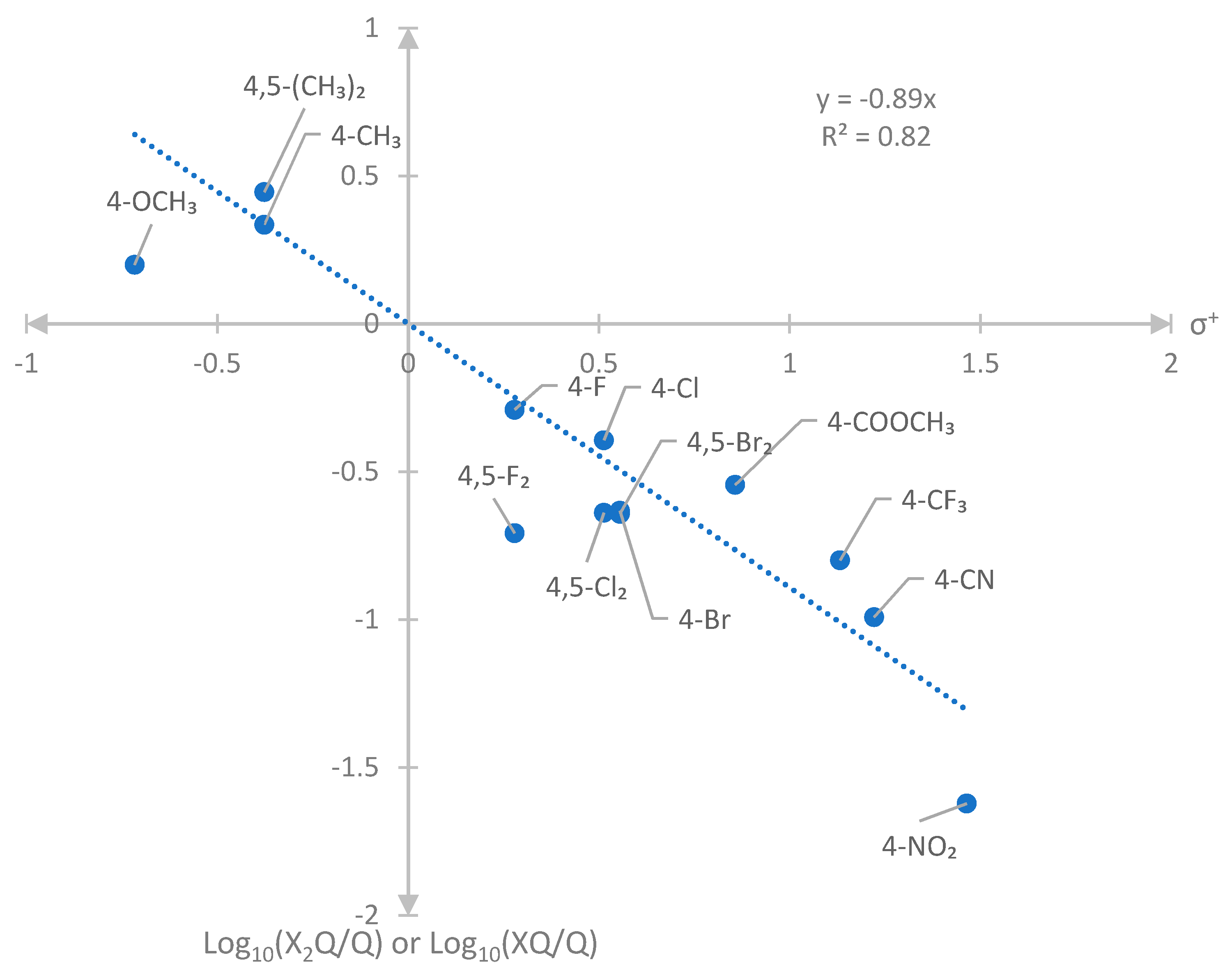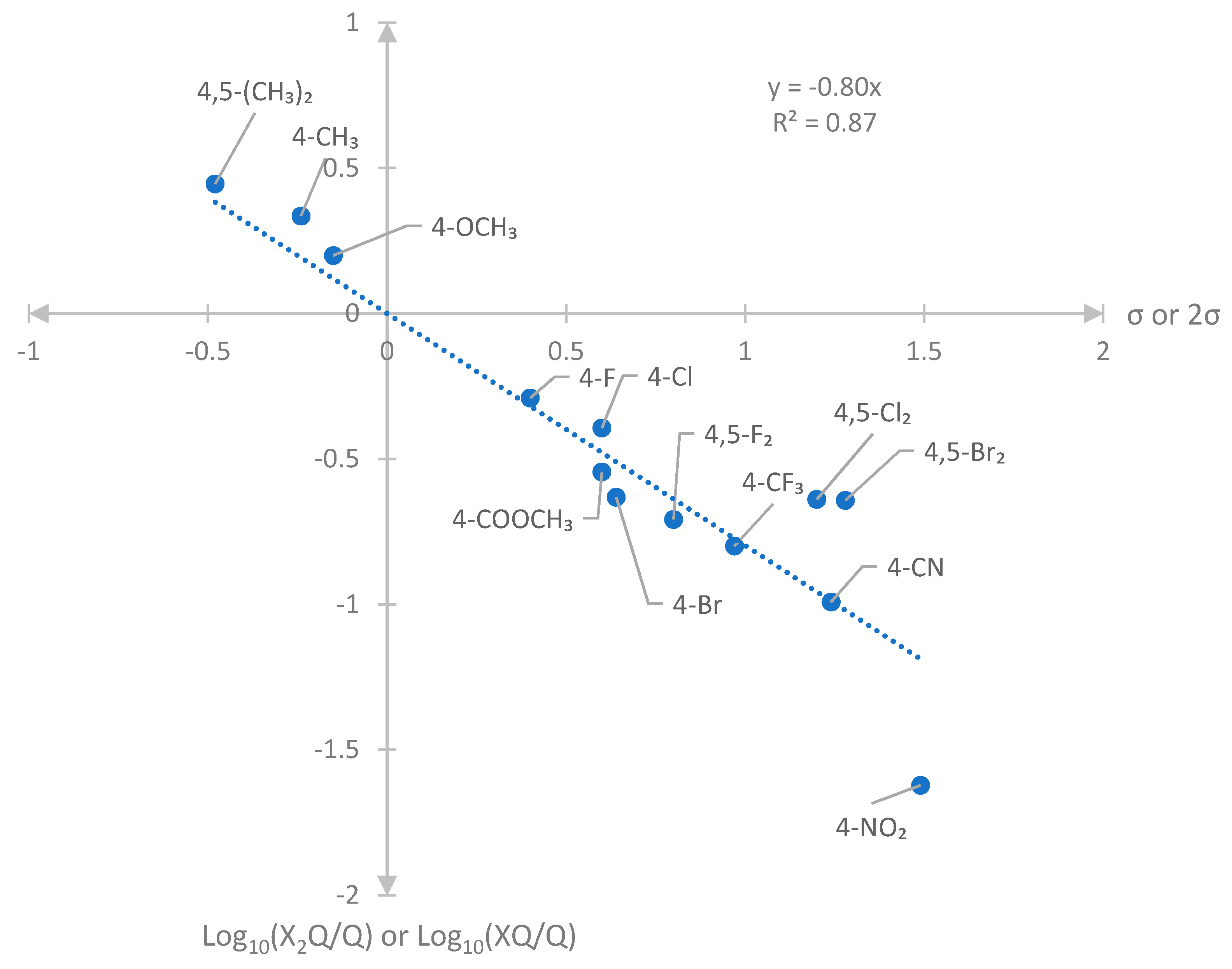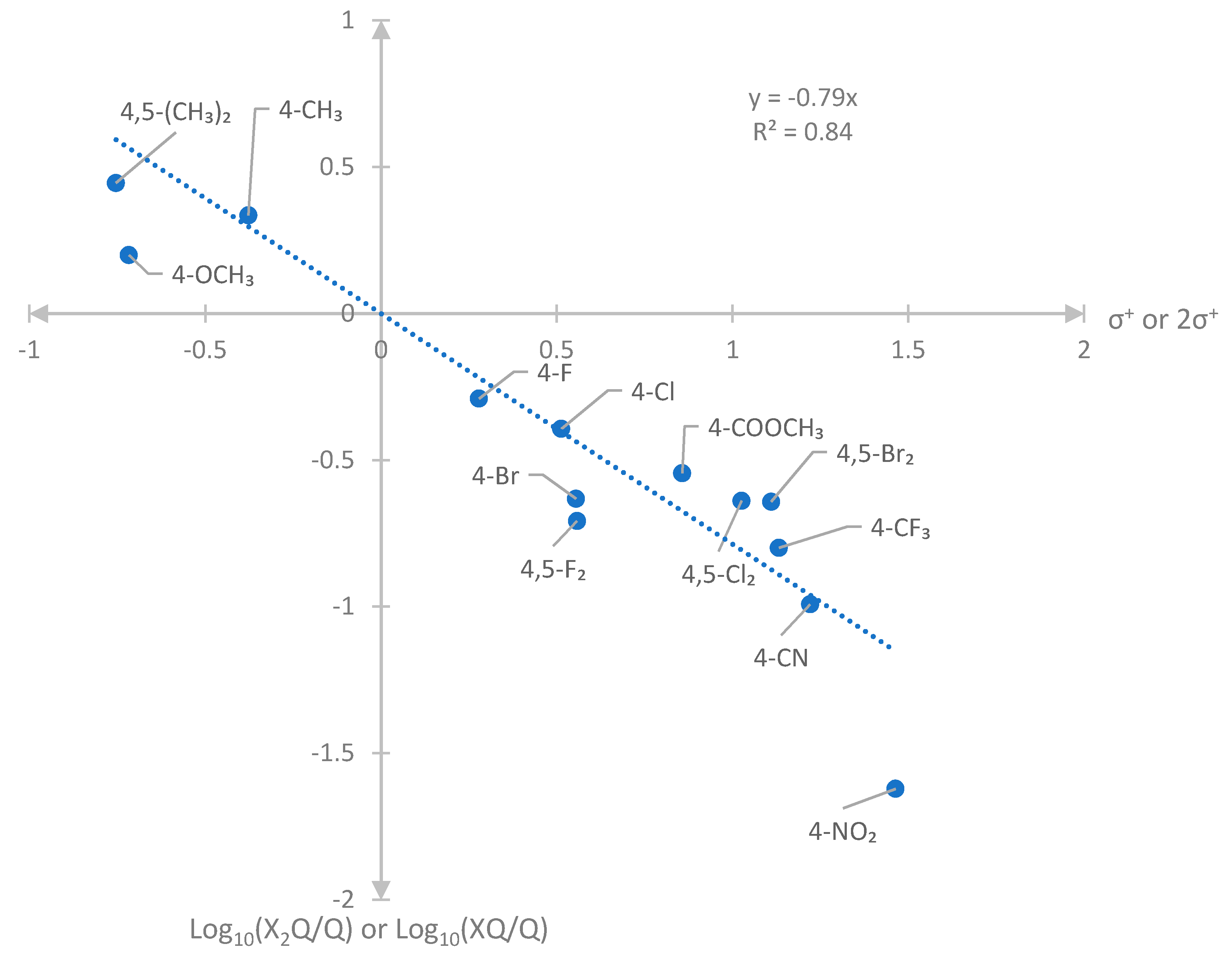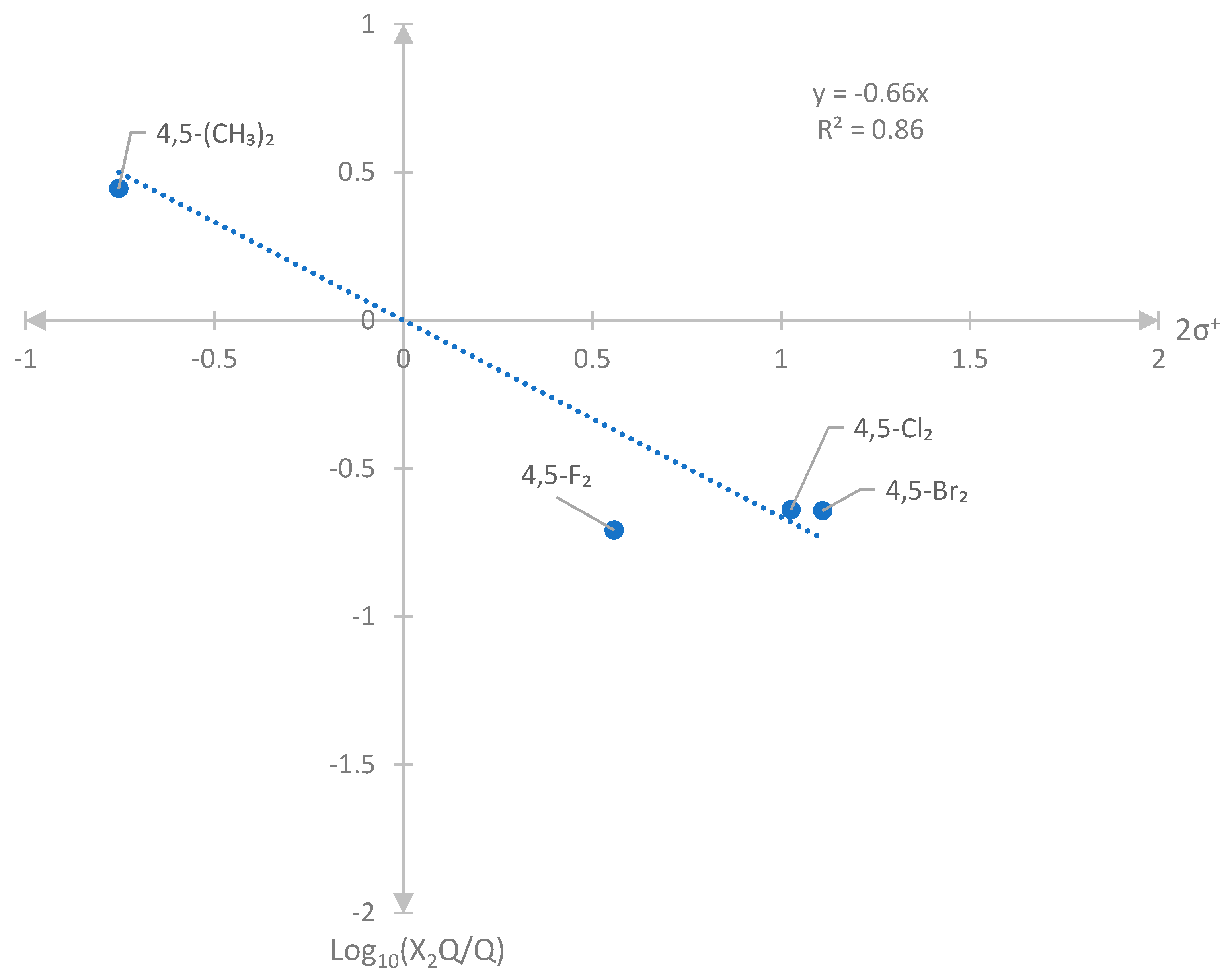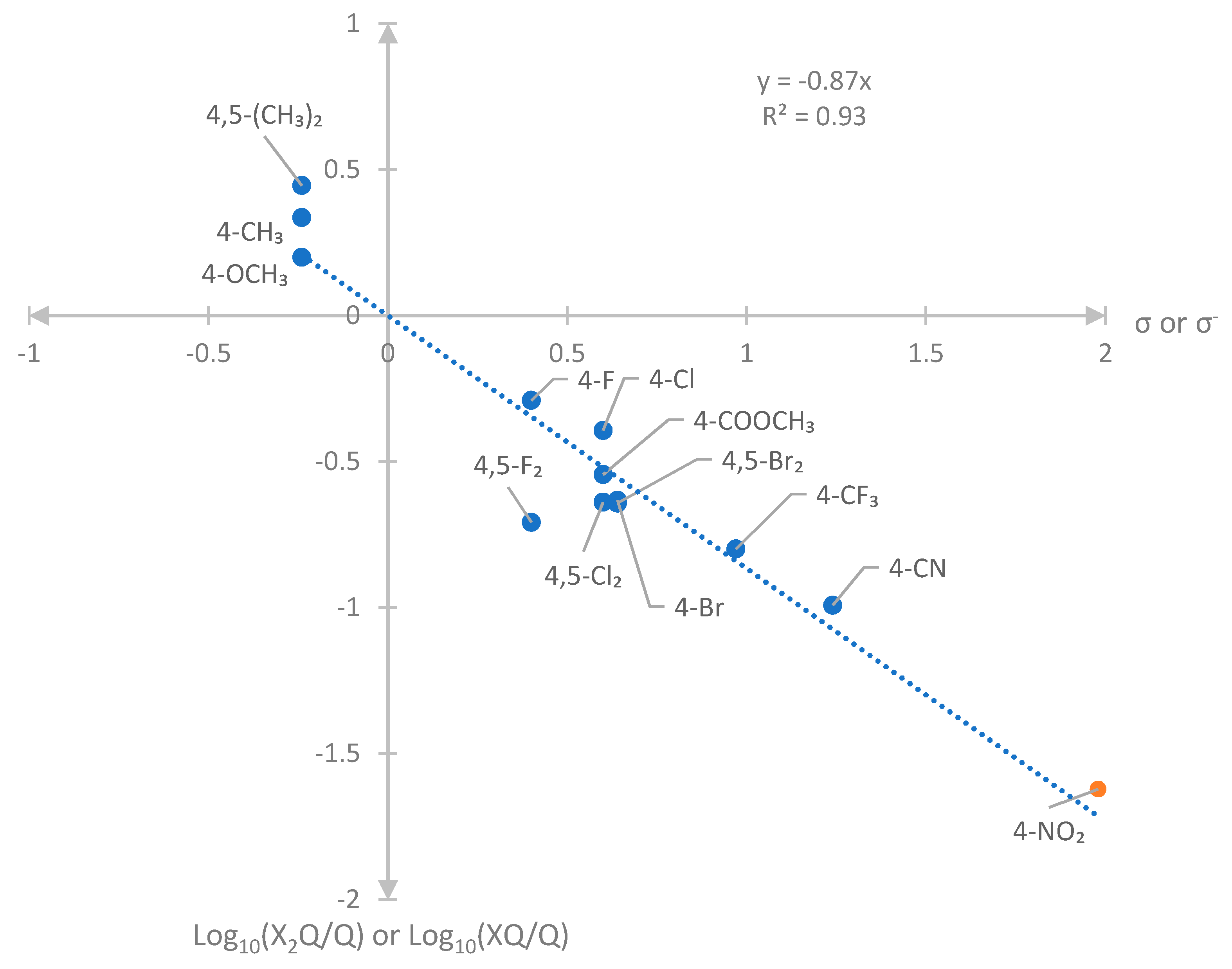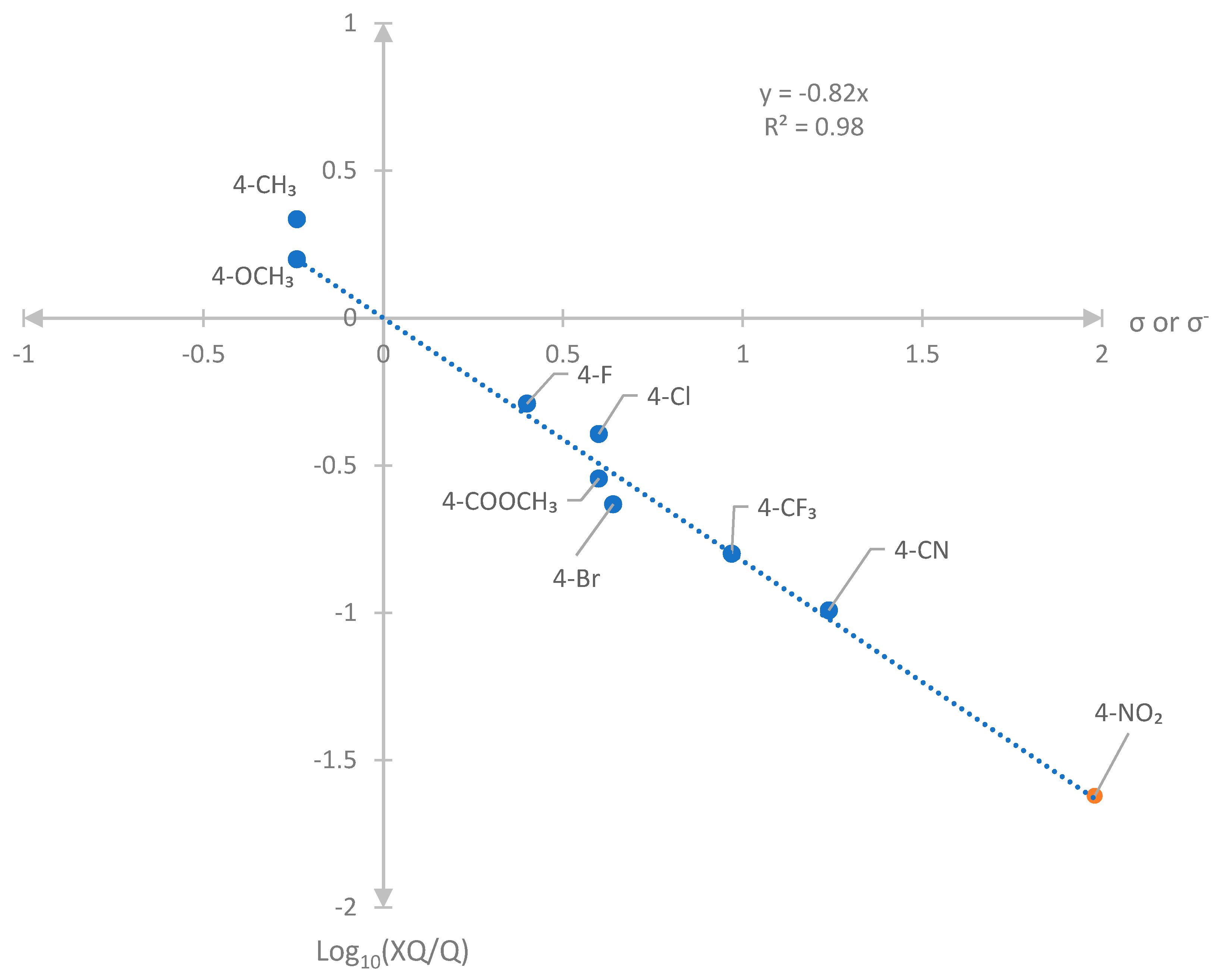1. Introduction
One recent scientific application of microdroplets is as an environment for conducting organic synthesis at an enhanced rate in mild conditions. Thus, various reactions, particularly condensations, occur far more rapidly in the microdroplets of the nebulizer of a conventional electrospray mass spectrometer source, often at or near neutral pH and at ambient temperature, when either acid or base catalysis or heat would be required in classical alternative preparative methods [
1,
2,
3,
4,
5]. The formation of C=N and C-N bonds, to produce heterocycles, in the microdroplets is especially effective, as exemplified by the Hantzsch synthesis of pyridine derivatives [
4] and the facile formation of 2,3-diarylquinoxalines [
6,
7]. Many other scientific investigations covering a wide variety of topics have been made in microdroplets generated in a nebulizer [
8,
9,
10,
11]. A recent definitive review summarizes the scope and potential for novel research in this field [
12].
One particularly relevant finding in the initial study of formation of quinoxalines (“offline”, when the nebulizer was not connected to the mass spectrometer) and protonated quinoxalines (“online”, when ions formed during the condensation could be directly analyzed by mass spectrometry) was the detection and characterization of positively charged intermediates that would be expected to be formed by nucleophilic attack of the phenylenediamine on the protonated benzil [
6].
The Hammett equation is a proven method for understanding in at least a semi-quantitative manner the influence of substituents on an aromatic ring on the reaction rate [
13,
14,
15]. Each substituent is assigned a number (the “σ constant”), obtained from experimental data, which summarizes its effects on the electron density in the ring and the consequences of these effects on the chemistry of a reactive site elsewhere in the molecule. Substituents in the 2-position normally are not considered because their electronic effects, which are of primary interest, may be obscured or overridden by steric effects. A substituent with a negative σ constant is electron releasing; consequently, it generally increases the electron density in the ring (thus potentially enhancing the nucleophilicity of another electron-donating group on that ring or reducing the electrophilicity of any electron-attracting group). On the other hand, a substituent with a positive σ constant is electron attracting; therefore, it tends to diminish the electron density in the ring (which might reduce the nucleophilicity or enhance the electrophilicity of the other group). In favorable circumstances, where there is a good correlation between the σ constant and the reactivity of the other group, a Hammett plot gives a straight line with a slope that is characteristic of the reaction (the “ρ constant” or “ρ value”), which gives insight into the nature of the process. A negative ρ value shows that the rate-limiting step involves a decrease in negative charge (or an increase in positive charge) on the other group, as would be expected if this second group acts as a nucleophile in the reaction. Conversely, a positive ρ value reveals that there is an increase in negative charge (or a reduction in positive charge) on the second group in the rate-limiting step, as would be anticipated if this second group was behaving as an electrophile.
In practice, reactions are usually studied by this powerful method by obtaining data for species with substituents with various σ constants, so as to obtain the ρ value for the process by generating the relevant Hammett plot. In some cases, it is possible to obtain appropriate information from thermodynamic data (such as equilibrium constants for dissociation of substituted benzoic acids, as in the original work [
13,
14]) or kinetic data (by measuring the actual rates of comparable processes). In other instances, in which obtaining “absolute” data is impossible or impractical, relative rates may be determined from the relative abundance of two possible products formed in competition experiments [
16,
17,
18].
Certain substituents participate so extensively in π-conjugation with aromatic rings that the use of standard σ constants values does not adequately summarize their influence on the electron density distribution in the aromatic ring to which they are attached. In these cases, the use of σ+ or σ− constants often gives better Hammett plots [
19,
20]. A σ+ constant is appropriate in cases in which the substituent is powerfully electron-donating (corresponding to a strong +M mesomeric effect, as for example for an amino, NH
2, group). In contrast, a σ− constant is suitable for powerfully electron-withdrawing groups such as NO
2 that have a strong −M mesomeric effect).
The approach of applying competition experiments to obtain relative rate data was previously [
7] exploited by measuring the quantities of 2,3-diphenylquinoxaline and the corresponding 2,3-diarylquinoxaline formed when phenylenediamine reacted with equimolar quantities of benzil and a 3,3′- or 4,4′-disubstituted benzil,
Scheme 1. The names of the reactants and products are abbreviated as follows:
P,
B and
Q represent, respectively, 1,2-phenylenediamine, benzil and 2,3-diphenylquinoxaline;
BY2 and
QY2 represent the 3,3′- or 4,4′-disubstituted benzil and the derived 2,3-diarylquinoxaline containing substituents, Y, in the pendant aryl rings.
Previous work also established that measuring the relative abundance of
Q and
QY2 from the intensity of the [M+H]
+ signals in the positive ion electrospray, ESI+, spectra in “online” experiments (in which the effluent from the nebulizer in liquid chromatography mass spectrometry, LC-MS, analysis was introduced into the mass spectrometer) did not give satisfactory data. This disappointing outcome was attributed to the non-linear response of the detector to the [M+H]
+ ions and difficulties in accurately calibrating this response. However, when the ratio of
Q and
QY2 obtained by transmission of starting materials through the nebulizer in “offline” competition experiments was measured by liquid chromatography using the UV detector, a good Hammett correlation, with a ρ constant of 1.87 and a correlation factor (“R
2” value) of 0.90 was obtained [
7].
Closely similar results (a ρ value of 1.83 and an R
2 value of 0.89) were obtained when the quantities of
Q and
QY2 were measured by the relative areas of the peaks in the total ion chromatogram, TIC, of signals in the gas chromatography mass spectrometry, GC-MS, analysis under electron ionization, EI, conditions of the product mixture. This protocol is especially attractive because it is possible to analyze a large number of mixtures by means of the auto-sampler on the GC-MS system [
7].
These results revealed that there is a substantial increase in the electron density at the carbonyl carbon atom of the benzil during the rate-limiting step in the accelerated condensation, which in turn implies that the benzil is behaving as an electrophile.
This preliminary work suggests that further research to answer two questions is desirable. Firstly, is it possible to establish that the phenylenediamine component behaves as a nucleophile by complementary experiments, in which phenylenediamine (
P) and a substituted phenylenediamine (abbreviated to
XP or
X2P,
Scheme 2) compete to condense with benzil?
Secondly, is the use of σ values appropriate for all cases? Would it be more appropriate to use σ+ or σ− values [
20], especially for substituents in the 4-position which interact strongly by π-conjugation with the reactive site by the mesomeric effect? These investigations are slightly complicated by the fact that a substituent that is in the “para” 4-position relative to one amino substituent in
XP or
X2P will be in the “meta” 3-position relative to the other amino substituent. However, in such cases, composite σ, σ+ or σ− constants may be derived [
21], thus facilitating the analysis.
3. Discussion
Firstly, the presence of an electron-donating substituent (CH3 or CH3O) in XP accelerates the condensation, thus favoring formation of XQ over Q, as shown by a ratio of XQ/Q that is greater than unity. At first sight, it is surprising that a methyl substituent has a more activating effect (XQ/Q ratio of 2.16) than a methoxy group (XQ/Q ratio of only 1.58). However, this apparent anomaly is explicable in terms of the composite σ constants that are necessary because a substituent para to one NH2 group is meta relative to the other. A methyl group in either the para or meta position is electron releasing thus enhancing the nucleophilicity of the amino group(s) (σ constant of −0.07 and −0.17, respectively). In contrast, a para methoxy group is electron releasing (and activating, with a σ constant of −0.27, because of its powerful +M mesomeric effect, which overrides the −I inductive effect), but a meta methoxy group is electron-withdrawing (and deactivating, with a σ constant of 0.12, because its mesomeric effect is negligible, but its −I inductive effect is stronger because the meta position is closer to the amino group than the more distant para position). The standard composite σ constant for a methyl and methoxy group is −0.24 and −0.15, respectively.
Secondly, an electron-withdrawing and deactivating substituent (F, Cl, Br, and especially CH3CO2 CF3, CN, or NO2) has the opposite effect, reducing the nucleophilicity of the amino group(s), which leads to preferential formation of Q, as indicated by a XQ/Q ratio below unity.
Thirdly, these trends are generally reinforced in the less extensive data in the disubstituted series, as would be expected if the influence of two substituents was additive or multiplicative. Thus, the X2Q/Q ratio of 2.79 when (CH3)2P competes with P to condense with B is larger than that (2.16) in the corresponding competition experiments involving CH3P and P because there are two activating substituents in (CH3)2P. Conversely, when two deactivating substituents are present, the X2Q/Q ratio is smaller than when there is only one such substituent, as illustrated by the ratios of 0.196 and 0.512 when F2P and FP, respectively, compete with P to condense with B to form F2Q and FQ. However, the trend in which the second substituent reinforces the first appears to decline on progressing through the series X = F, Cl and Br.
Fourthly, although the deactivating influence of the nitro group in O2NP is greater than that of any other electron-withdrawing substituent, as revealed by the XQ/Q ratio of only 0.024, O2NQ is formed in the microdroplets produced in the nebulizer. This finding emphasizes the acceleration of the rate of condensations of this kind in microdroplets. Even after prolonged heating for 5–12 h at 80 °C in ethanol, there was no evidence from thin layer chromatography, tlc, of the formation of appreciable quantities of O2NQ from O2NP and B in conventional solution experiments. Indeed, the preparation of reference O2NQ entailed overnight heating of equimolar quantities of O2NP and B in ethylene glycol (or glycerol) at 120–150 °C.
These trends in the
XQ/Q or
X2Q/Q ratio can be interpreted in greater detail by constructing a Hammett correlation.
Figure 1,
Figure 2,
Figure 3,
Figure 4,
Figure 5,
Figure 6,
Figure 7 and
Figure 8 show the plots that result by considering various methods for assigning constants to the substituent(s). In this discussion, ρ constants and R
2 values are quoted to two decimal places.
Figure 1 is constructed on the basis of standard composite σ constants. The result is a good correlation, with a ρ value of −0.96 and an R
2 value of 0.96, which is comparable with that (0.89 or 0.90) obtained in the earlier competition experiments in which
B and
BY2 competed to condense with
P to form
Q and
QY2 [
7]. This good agreement suggests that using standard σ values generally may be appropriate in these analyses.
Figure 2 is constructed using composite σ+ constants. In general, σ+ constants tend to be more appropriate than σ constants in cases in which there is strong stabilizing conjugative interaction (typically by the mesomeric effect) of the substituent with the second group (acting as a nucleophile or electrophile). There is a slight numerical reduction in the ρ value (to a less negative value of −0.89) relative to that derived on the basis of sigma constants; moreover, there is a somewhat larger decline in the R
2 value (to 0.90).
Figure 3 and
Figure 4 show the corresponding graphs that are constructed if the composite σ or σ+ constants are doubled to allow for the presence of two substituents in
X2P. With doubled composite σ constants, ρ is numerically reduced to −0.80, with an R
2 value of 0.93, which is slightly less than that obtained in
Figure 1. When doubled σ+ constants are employed, the numerical value of ρ falls a little further, (to −0.79), and the R
2 factor is slightly reduced (to 0.91). In each case, the numerical value of ρ is reduced, relative to that when standard composite σ or σ+ constants are used. Moreover, the R
2 values are also appreciably less impressive when doubled σ or σ+ constants are employed. These factors suggest that there is little, if any, advantage in employing doubled constants to construct Hammett correlations in this system, even though there are qualitative trends in the
X2Q/Q compared to the
XQ/Q ratio that appear to indicate that the second substituent does have an effect that reinforces that of the first substituent.
The idea that caution is necessary in using doubled σ or σ+ constants is confirmed by considering the Hammett plots of
Figure 5 and
Figure 6, that are obtained from only the four
X2Q/Q ratios. The derived ρ constant (−0.60 and −0.66, respectively) is significantly reduced, partly because the doubling of the σ or σ+ constants stretches the abscissa), thus suggesting that this procedure may be inappropriate, even if relatively good R
2 values (0.93 and 0.92, respectively) are obtained. Moreover, the point for X = F is out of line with the other three cases in both graphs, thus suggesting that the approximations in deriving doubled σ or σ+ constants do not always hold good.
Another obvious feature of the best Hammett plot of
Figure 1 is that the point for X = NO
2 lies appreciably out of line with those for the other electron-withdrawing substituents. As noted previously,
O2NP is so deactivated that condensing it with
B in classical solution experiments to form
O2NQ requires the use of a different solvent and higher temperatures. This greatly reduced reactivity reflects the powerful −M effect of the nitro group. If the σ− constant is used for this substituent to produce the Hammett plot of
Figure 7, the R
2 value is increased to 0.96 and the ρ constant becomes −0.87. These improvements are further enhanced if the problematic doubly substituted cases are excluded, giving a ρ constant of −0.82 and an R
2 value of 0.99.
Several significant deductions may be made from these Hammett correlations. Firstly, despite variations in the ρ values derived from
Figure 1,
Figure 2,
Figure 3,
Figure 4,
Figure 5,
Figure 6,
Figure 7 and
Figure 8, it is clear that the electron density on the amino group(s) is reduced during the rate-limiting step in the accelerated condensation that forms
XQ or
X2Q in the microdroplets. In turn, this finding indicates that
P,
XP or
X2P behaves as a nucleophile in the condensation. This result complements the earlier finding that the electron density on the carbonyl group of the benzil increases during the rate-limiting step of the reaction, thus indicating that this component behaves as an electrophile [
7].
Secondly, the magnitude of ρ (−0.96 when σ constants are used in
Figure 1, or −0.82 if the σ− constant is used only for X = NO
2, but σ constants are used for all other substituents) reveals that the reduction in electron density on the amino group(s) is considerable, corresponding to approximately half the value of −1.88 for hydrolysis of substituted benzyl chlorides in acetone and water at 69 °C [
22]. It is, however, numerically smaller than the value of 1.86 that was found in the previous investigation of the condensation of
P with
B and
BY2 [
7]. Several explanations may be devised for this difference. One obvious, if somewhat speculative, possibility is that there are two amino groups in
P,
XP and
X2P, which means that the effect of a substituent will be divided between these groups, thus reducing its effect on either.
Thirdly, despite the complication caused by the presence of two amino groups in XP, one of which is para to X, whereas the other is meta to X, a valuable analysis using composite substituent constants is possible. If only one variety of substituent constant is used, the best correlation occurs for standard σ constants, with a good R2 value of 0.92. Substituting σ+ constants gives a significantly less good correlation (R2 value of 0.82). Similarly, there is little, if any, benefit in using “doubled” substituent constants in constructing Hammett plots in this system. However, there is a case to use the σ− constant for the nitro group, which has a particularly powerful −M effect, in which case an even better correlation (R2 value of 0.99) is obtained.
4. Materials and Methods
The required
Q,
XQ and
X2Q reference samples were prepared from commercial starting materials of high purity by condensation of
P,
XP or
X2P with
B, usually in ethanol at ~80 °C [
23] [but in ethylene glycol or glycerol at 120 °C for
O2NQ, which was not formed at an appreciable rate in ethanol]. All these materials had the expected spectroscopic properties; no impurities were detected by GC-MS or other means.
The competition experiments were conducted by a slight modification of the method described previously [
7]. In brief, equimolar quantities of
P,
XP or
X2P with
B in freshly prepared solution in methanol were mixed. Two 300 μL portions of the combined solution containing these components were transmitted via a Hamilton syringe through the nebulizer of a Z-spray
TM electrospray ionization source of a Waters mass spectrometer. The nebulized spray was collected, taken at once into the syringe, transmitted again through the nebulizer, collected again, and transmitted through the nebulizer a third time, collected and analyzed by injection into the GC-MS system. This triple transmission through the nebulizer gave a conversion (usually 30–70%) that facilitated analysis of the resultant mixture of products. As noted in previous work, the reactions in the microdroplets in the nebulizer at room temperature took place much more quickly than the classical solution syntheses (which usually required 1–5 h at 80 °C). Condensation of the components before or after transmission through the nebulizer was shown to be insignificant by control experiments in which mixtures of
P,
XP or
X2P with
B were allowed to stand in solution at room temperature.
During the initial exploratory work, the possibility of performing four component experiments was investigated, but found to entail practical difficulties. In response to the suggestion of a reviewer, a mixture of equimolar solutions of
P,
(CH3)2P,
B and
B4,4′F2 was transmitted through the nebulizer as described above. The chromatogram and associated peak areas (
Figure S14 and Table S14) were satisfactory in this case; however, the increased possibility of peak overlap and the greater difficulty in interpreting the data make this otherwise attractive option less reliable than doing a series of three component reactions.
The GC-MS analysis was performed on a 7890 gas chromatograph attached to a 5975 EI Inert MSD (Agilent Technologies, Santa Clara, CA, USA) operating at 70 eV; the temperature of the source and quadrupole was 230 and 150 °C, respectively. Data were acquired over the m/z range 50–450. Samples of the solution obtained after transmission through the nebulizer were admitted to a split/splitless inlet held at 300 °C with a 2:1 split. Chromatographic separation of components was achieved in a 30 m × 0.25 mm 5% diphenyl low-polarity fused-silica capillary column, using helium as the carrier gas at a flow rate of 1.2 mL min−1. The initial temperature was 100 °C, increasing linearly at 25 °C minute−1 to 350 °C, where it was maintained for 2 min.

